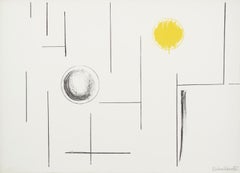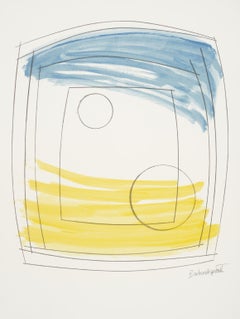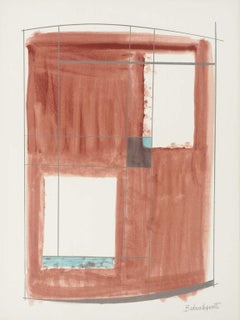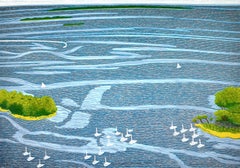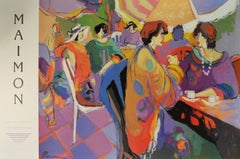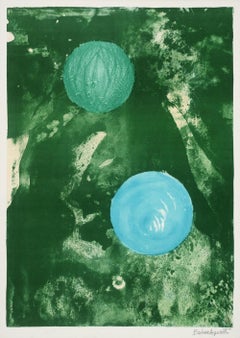Barbara Hepworth Art
Barbara Hepworth was born in 1903 in Wakefield, West Riding of Yorkshire. Hepworth attended the Leeds School of Art from 1920. There, she met fellow sculptor Henry Moore, who she maintained a friendly rivalry with throughout her career.
From Leeds, Hepworth went on to attend the Royal College of Art (RCA) in London, where she studied from 1921–24. Following her studies in London, Hepworth traveled to Italy. She began this journey in Florence, where she was the runner-up for the Prix-de-Rome, losing only to sculptor John Skeaping, whom she began a relationship with. The pair traveled to Siena and Rome and were married in 1925 in Florence.
During her time in Italy, Hepworth studied under sculptor Giovanni Ardini and learned how to carve marble. Upon her return to London, Hepworth and Skeaping began to publicly exhibit from their flat until their divorce in 1929. Hepworth’s early work reflects her interest in European art movements, particularly Italian Abstraction.
In 1931, Hepworth began to sculpt her characteristic pierced figures, and Henry Moore followed suit. The pair led the path to modernist sculpture. Hepworth later became involved with the Parisian art movement, Abstraction-Création.
In 1933, Hepworth and Ben Nicholson co-founded with Paul Nash, Herbert Read and architect Wells Coates the Unit One art movement, with the agenda to unite Surrealist practice with abstraction in contemporary British art. Hepworth moved to St. Ives, Cornwall with her second husband Nicholson and their children at the outbreak of the Second World War in 1939. Hepworth lived and worked in Trewyn Studios.
Many other British artists likewise found refuge and space in Cornwall to continue working during the war, and in its aftermath, Hepworth founded the Penwith Society of Arts in 1949.
In 1950, Hepworth exhibited in the British Pavilion at the Venice Biennale. Two of her public commissions were exhibited at the Festival of Britain in 1951, and in 1953 she traveled to Greece, a trip which inspired her celebrated six-piece sculpture collection carved from Guarea wood between 1954–56. In 1955, Hepworth began to exhibit in the USA, beginning with the Martha Jackson Gallery. Preferring the European art market, she exhibited solo at Galerie Chalette, France in 1957, and her lithographs were hung in Marlborough Fine Art in 1970.
The Barbara Hepworth Museum in St Ives and the Hepworth Wakefield in West Yorkshire permanently exhibit her work in honor of her contributions to both places that the artist at times called home. Her collectors include the Tate, the Dallas Museum of Art, the Art Institute of Chicago, the Museum of New Zealand Te Papa Tongrewa and the Lynden Sculpture Garden.
Hepworth was awarded the Grand Prix at the 1959 Sao Paulo Art Biennal, the Freedom of St Ives in 1968, a CBE in 1958, and a DBE in 1965. In 2015, the Tate Britain held the first big solo exhibition of Hepworth’s work since her death, bringing together more than 70 of her works.
Find Barbara Hepworth art for sale on 1stDibs.
(Biography provided by Shapero Modern)
1960s Barbara Hepworth Art
Lithograph
1960s Barbara Hepworth Art
Lithograph
1970s Barbara Hepworth Art
Lithograph
1960s Barbara Hepworth Art
Lithograph
1960s Barbara Hepworth Art
Screen
2010s Contemporary Barbara Hepworth Art
Lithograph
1990s Barbara Hepworth Art
Lithograph
1990s Pop Art Barbara Hepworth Art
Screen
1970s Barbara Hepworth Art
Lithograph
21st Century and Contemporary Barbara Hepworth Art
Lithograph
20th Century Post-War Barbara Hepworth Art
Lithograph
1980s Barbara Hepworth Art
Lithograph
1960s Abstract Geometric Barbara Hepworth Art
Paper, Mixed Media, Lithograph
21st Century and Contemporary Contemporary Barbara Hepworth Art
Paper, Archival Paper, Color, Screen, Linen
2010s Street Art Barbara Hepworth Art
Screen, Varnish
1970s Surrealist Barbara Hepworth Art
Lithograph
1970s Abstract Barbara Hepworth Art
Lithograph
1960s Barbara Hepworth Art
Lithograph
Barbara Hepworth art for sale on 1stDibs.
Artists Similar to Barbara Hepworth
- 1stDibs ExpertOctober 30, 2024Many things happened to Barbara Hepworth. She attended the Leeds School of Art from 1920. There, she met fellow sculptor Henry Moore. From Leeds, Hepworth went on to attend the Royal College of Art (RCA) in London, where she studied from 1921–24. Following her studies there, Hepworth traveled to Italy, beginning in Florence, where she was the runner-up for the Prix de Rome. She lost only to sculptor John Skeaping, with whom she began a relationship. The pair traveled to Siena and Rome and were married in 1925 in Florence. During her time in Italy, Hepworth studied under sculptor Giovanni Ardini and learned how to carve marble. Upon her return to London, Hepworth and Skeaping began to publicly exhibit their work from their flat until their divorce in 1929. Although Hepworth died in 1975, she remains an influential figure in art. In 2015, Tate Britain held the first big solo show of Hepworth’s work since her death, bringing together more than 70 works. On 1stDibs, find a wide range of Barbara Hepworth art.
- What materials did Hepworth use?1 Answer1stDibs ExpertSeptember 9, 2024Hepworth used a variety of materials over the course of her career. Of the more than 500 sculptures that the English artist produced, many feature different varieties of natural stone, such as gray alabaster, Seravezza marble and limestone. She also used other materials like silver, Burmese wood and bronze. Find a range of Barbara Hepworth art on 1stDibs.
- 1stDibs ExpertApril 5, 2022Barbara Hepworth made her sculptures out of a variety of materials. To create many, she used tools to carve into wood and stone. Her outdoor bronze sculptures like Single Form and Two Forms are particularly well known. On 1stDibs, shop a variety of Barbara Hepworth art.
- 1stDibs ExpertSeptember 16, 2024The reason why Barbara Hepworth created Madonna and Child relates to her personal history. In 1953, her son, Paul, was killed when his Royal Air Force plane crashed in Thailand. She produced the moving sculpture as a tribute to his memory. Today, the statue is on display in a memorial to Paul at the parish church of St Ives, England. On 1stDibs, explore a range of Barbara Hepworth art.
- 1stDibs ExpertSeptember 16, 2024The group of artists that included Barbara Hepworth was called Unit One. Paul Nash formed the group in 1933 in hopes of bringing together creative minds to promote a modern approach to architecture, art and design. In addition to Nash and Hepworth, the group included John Armstrong, John Bigge, Edward Burra, Wells Coates, Henry Moore, Colin Lucas, Ben Nicholson and Edward Wadsworth. Shop a variety of Barbara Hepworth art on 1stDibs.
- 1stDibs ExpertNovember 20, 2024Yes, Henry Moore and Barbara Hepworth were friends. The two met at the Leeds School of Art in the UK and maintained a friendly rivalry throughout their careers. Both Hepworth and Moore were members of Unit One, a group of British artists who sought to educate the public about avant-garde art during the 1930s. Shop a selection of Henry Moore and Barbara Hepworth art on 1stDibs.
- 1stDibs ExpertOctober 24, 2024Barbara Hepworth sculptures have holes in them because the sculptor was interested in how three-dimensional artworks interact with the spaces in which they are displayed. By piercing her wood, stone and metal sculptures, Hepworth allowed light to pass through her works and gave viewers the opportunity to catch glimpses of the settings that lay beyond her pieces. In addition, Hepworth stated that she liked those gazing at her work to be able to see the inside and outside of her sculptures simultaneously. On 1stDibs, find a collection of Barbara Hepworth art.
- Did Barbara Hepworth use clay?1 Answer1stDibs ExpertSeptember 16, 2024Yes, Barbara Hepworth did use clay. Although early in her career she favored wood and metal, Hepworth expanded her preferred materials in the 1950s, beginning to use not only clay but also bronze to create her sculptures. However, Hepworth famously did not use clay to produce models for her sculptures, preferring to work directly with her materials. On 1stDibs, explore a diverse assortment of Barbara Hepworth art.
- How much is a Barbara Hepworth?1 Answer1stDibs ExpertAugust 15, 2024How much a Barbara Hepworth is depends on its condition and other factors. In 2023, the English artist’s sculpture The Family of Man: Ancestor II sold for more than $11.5 million at a Christie's auction, setting a new record for the artist. Hepworth’s early work reflected her interest in European art movements, particularly Italian abstraction. In 1931, Hepworth began to sculpt her characteristic pierced figures, which tend to be the most highly sought-after examples of her work. If you own a work by Hepworth, a certified appraiser or experienced art dealer can aid you in the valuation process. On 1stDibs, find an assortment of Barbara Hepworth art.
- 1stDibs ExpertApril 5, 2022Barbara Hepworth was a British sculptor considered a leading figure in the international art scene. Her work in modernism is still held in high regard, with pieces like “Single Form” and “Two Forms” considered some of her most prestigious work. Shop a selection of Barbara Hepworth’s art on 1stDibs.
- 1stDibs ExpertSeptember 16, 2024The technique that Barbara Hepworth most often used was direct carving. Pioneered by sculptor Constantin Brâncuși during the early 20th century, this process involves using tools to shape the materials and allowing shapes to emerge naturally. It differs from more traditional forms of carved sculpture, which involve the use of plaster or clay models. On 1stDibs, explore a range of Barbara Hepworth art.
- 1stDibs ExpertOctober 30, 2024Barbara Hepworth made many of her sculptures at her home studio. From 1939 until her death in 1975, she resided in St Ives, Cornwall, England. Today, her former home and studio are a museum dedicated to her life and work. Explore a wide variety of Barbara Hepworth art on 1stDibs.
- Why was Hepworth so important?1 Answer1stDibs ExpertOctober 30, 2024Hepworth was so important for a few reasons. Barbara Hepworth helped to push the art of sculpture in a new direction with her pieces that featured pierced details that provided a view of the setting beyond the artwork. Her considerations of space influenced the work of many other sculptors, including her contemporary Henry Moore. As a founding member of the Unit One artist movement, Hepworth also helped disseminate avant-garde artists' ideals throughout Britain during the 1930s. Her collectors include the Tate, the Dallas Museum of Art, the Art Institute of Chicago and the Museum of New Zealand Te Papa Tongarewa. In 2015, Tate Britain held the first big solo show of Hepworth’s work since her death, bringing together more than 70 of her works. Many experts believe her enormous success helped pave the way for future generations of women in the arts. On 1stDibs, explore a diverse range of Barbara Hepworth art.
- 1stDibs ExpertOctober 30, 2024Yes, Barbara Hepworth knew Henry Moore. They met while she was attending the Leeds School of Art in the 1920s. Moore and Hepworth maintained a friendly rivalry throughout their careers. Along with Paul Nash and Ben Nicholson, the two founded the Unit One art movement in 1933. The movement's purpose was to promote avant-garde art in the UK. Explore a wide variety of Barbara Hepworth art.
- 1stDibs ExpertOctober 30, 2024Barbara Hepworth worked in a number of mediums. She is best known for her sculptures, which she produced out of clay, bronze, stone and wood. Hepworth also created prints, including serigraphs and lithographs. Find a collection of Barbara Hepworth art on 1stDibs.
- 1stDibs ExpertNovember 4, 2024Barbara Hepworth used bronze for a few reasons. Hepworth intended for some pieces to be displayed outdoors and bronze is a weather-ready material. Because it can be melted and poured into a mold, bronze also made it possible for Hepworth to create her distinctive pierced, fluid sculptures, whereas it was more difficult to achieve the same effects with wood and stone. In addition, brass enabled Hepworth to quickly make multiple editions of the same work. On 1stDibs, find a selection of Barbara Hepworth art.
